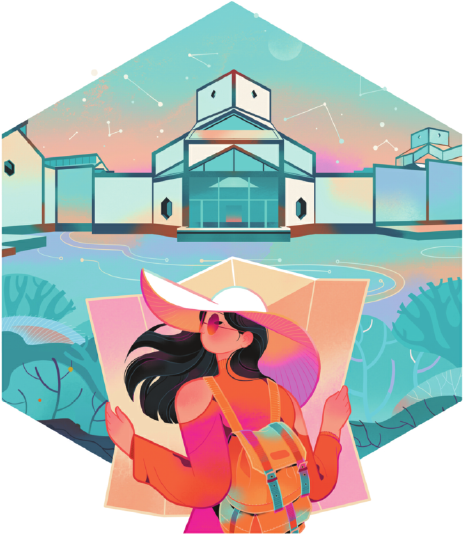By XIE XIAOTING and LI TING Source:China Daily 2024-10-12

SONG CHEN/CHINA DAILY
Visiting a museum or going on a study tour is a fast developing social trend, which has significantly increased footfalls at major, popular museums. Such has been the rush of visitors that many museums have extended their opening hours. What's more, the visitors comprise not only history and archeology lovers, but also an increasing number of ordinary people.
All this suggests the cultural tourism sector is showing strong recovery, which in turn has accelerated culture-tourism integration.
However, the rapidly rising footfalls have presented new challenges for the museums, as they have to cater to the visitors' demand for special, if not customized, cultural services, and take measures to better facilitate academic research.
The experience of the Suzhou Museum in Jiangsu province may give readers an idea about what the museums should do to deal with the onrush of visitors.
First, the museums should consider extending their role beyond the traditional realm of education and research, and integrate into the local tourism sector. They could, for example, conduct surveys to determine what sort of cultural services they should provide to meet the needs of the visitors.
In fact, the Suzhou Museum conducted a survey of visitors through a questionnaire in 2007 which made it realize that the majority of the visitors were young and middle-aged, well-educated women who were very active on social media. And social media users influence people's travel habits or decisions, giving rise to trends such as whirlwind tour and "city walks".
Data collected from several social media platforms showed that, in general, visitors to museums care more about viewing the displays, enjoying tea or coffee breaks, experimenting with customized products, sharing information and data on social media, and knowing the city well. This prompted the Suzhou Museum to publish a pocketbook as a special product, which provides information on not only the museum's collections but also the other tourist attractions in Suzhou.
Second, the application of digital technology can promote reform in the cultural relic and artwork field. No wonder digitalized exhibitions and displays of museum artifacts and intelligent services have become popular in China.
Some museums have also found novel ways of interacting with online audiences. Using high-precision 3D virtual modeling, an entire museum, complete with its setting, environment and collections, can be reproduced online for people to more closely observe the artifacts. Also, online exhibitions can give audiences the chance to study relic-related culture and history. In fact, online exhibitions have broken the barriers of space, offering people a multidimensional view of the museum's collections.
Third, cross-border integration of cultural and educational resources has become a new trend at a time when China is promoting long-term learning and education. China has introduced policies to encourage students to visit museums and enhance their knowledge of the past, and complement that experience with school syllabus-related lessons.
On campus, students can participate in symposiums, relic and artwork-related courses, and voluntary service activities. In Jiangsu province, for example, 20 local teachers have been selected to explore the joint development of museums and schools.
And fourth, museums should develop services for elderly people too, given the fact that elderly people account for more than 20 percent of China's total population. In this regard, the Suzhou Museum conducted a survey of more than 800 people aged 60 or above through questionnaires and interviews last year. The respondents were asked about their views on museums, how often they visited museums, their experiences of visiting museums, and what more they wanted from museums. A draft regulation was prepared based on the response of the elderly people.
Museums can develop age-friendly services in accordance with the physical health, cultural preferences, spiritual needs and interests of the elderly visitors, and improve their services by making the venue user-friendly for wheelchair users and people living with disability, and providing emergency medical services.
Museum brochures, boards and labels of exhibitions for the elderly people should be easy to read and understand, while museum websites should provide detailed information on the services offered by the museum. The museums should also exhibit the artifacts in a way that visitors, especially elderly people and people with disability, can view them with minimum effort in the shortest possible time. Only by paying attention to the real needs of the people can museums provide better cultural services.
Xie Xiaoting is curator of the Suzhou Museum; and Li Ting is deputy director of the coordinative training department of the museum. The views don't necessarily reflect those of China Daily.
The views don't necessarily reflect those of China Daily.
If you have a specific expertise, or would like to share your thought about our stories, then send us your writings at opinion@chinadaily.com.cn, and comment@chinadaily.com.cn.
Copyright © Xizang Daily & China Xizang News All rights reserved
Reproduction in whole or in part without permissions prohibited
Index Code: 藏 ICP 备 05000021 号
Producer: Xizang Daily International Communication Center